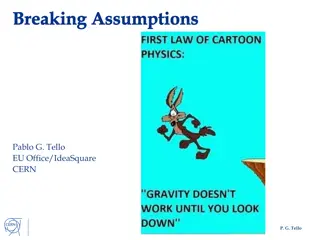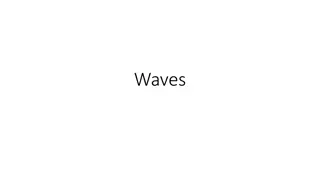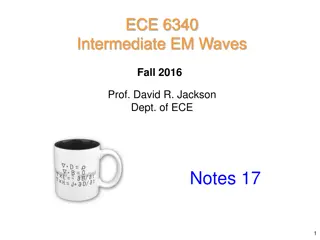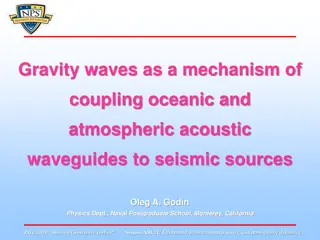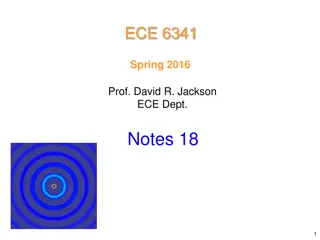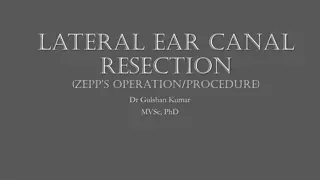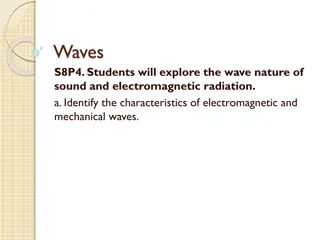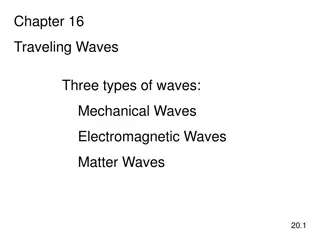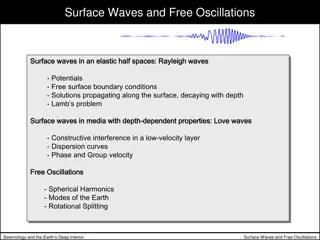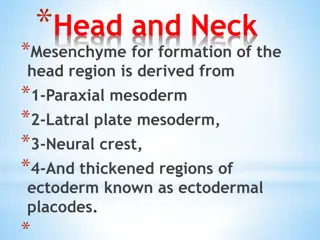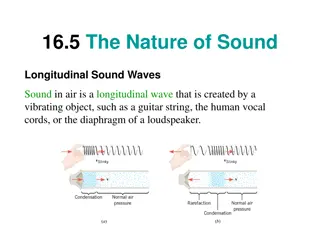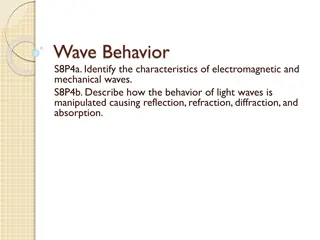
Steepest-Descent Path Physics Analysis
Explore the steepest-descent path physics analysis of line sources on a grounded slab, examining branch points, transformations, proper and improper planes, and the mapping of quadrants in the kx plane. Understand the significance of leaky-wave poles and field comparisons in the context of steepest-descent methods.
Download Presentation

Please find below an Image/Link to download the presentation.
The content on the website is provided AS IS for your information and personal use only. It may not be sold, licensed, or shared on other websites without obtaining consent from the author. If you encounter any issues during the download, it is possible that the publisher has removed the file from their server.
You are allowed to download the files provided on this website for personal or commercial use, subject to the condition that they are used lawfully. All files are the property of their respective owners.
The content on the website is provided AS IS for your information and personal use only. It may not be sold, licensed, or shared on other websites without obtaining consent from the author.
E N D
Presentation Transcript
ECE 6341 Spring 2016 Prof. David R. Jackson ECE Dept. Notes 37 1
Line Source on a Grounded Slab y x r ( ( ) ) ( ( ) ) + TE in TE in TE Z Z k k Z Z k k = j A E ( ) 0 = x x TE k z z x TE 0 x x 0 0 I 1 + ( ) jk y = + jk x TE 1 A k e e dk 0 y ( ) x ( (even function of ky1) ) = TE in TE z x x tan Z k jZ k h 4 j k 1 1 x y 0 y ( ) ( ) 1/2 1/2 = = 2 0 2 x 2 2 x k k k k k k = TE 0 Z 0 1 1 y y 0 k 0 y = TE 0 Z = xk k There are branch points only at 1 k 0 1 y 2
Steepest-Descent Path Physics Steepest-descent transformation: = = sin cos k k k k 0 0 0 x y There are no branch points in the plane (cos is analytic). Both sheets of the kx plane get mapped into a single sheet of the plane. 3
Steepest-Descent Path Physics Examine ky0 to see where the plane is proper and improper: ( ) = + cos k k j 0 0 y r i = cos cosh sin sinh k j 0 r i r i = Im sin sinh k k 0 0 y r i Proper Improper :Im 0 k 0 y :Im 0 k 0 y 4
SDP Physics (cont.) = Im sin sinh k k 0 0 y r i Proper Improper :Im 0 k P: proper I: improper 0 y i :Im 0 k 0 y C I I P P r 2 2 P I I P 5
SDP Physics (cont.) Mapping of quadrants in kx plane = = + sin sin cosh cos sinh k k k j 0 0 x r i r i k xi 0k i 2 0k 1 C k 3 4 P I xr 3 4 I P 2 1 SWP r LWP 2 2 3 4 P I 1 2 P I 6
SDP Physics (cont.) Non-physical growing LW poles (conjugate solution) also exist. i C P I 3 4 I P 2 1 SWP r LWP 2 2 3 4 P I = * LW x k k 1 2 P xp I ( ) = + = conj r /2 /2 The conjugate pole is symmetric about the /2 line: r r = conj i i 7
SDP Physics (cont.) ( ) = cos cosh 1 SDP: r i i C A leaky-wave pole is considered to be physical if it is captured when deforming to the SDP (otherwise, there is no direct residue contribution). SWP SDP r 2 LWP 2 = 0 8
SDP Physics (cont.) Comparison of Fields on interface ( = / 2): ( ) LW x = jk x 2 Res z E j e LWP: (exists if pole is captured) = LW xk j jk x e 0 E A SDP: (from higher-order steepest-descent method) z 3/2 x The leaky-wave field is important if: 1) The pole is captured (the pole is said to be physical ). 2) The residue is strong enough. 3) The attenuation constant is small. 9
SDP Physics (cont.) LWP captured: b i SDP The angle b represents the boundary for which the leaky-wave pole is captured (the leaky-wave field exists). b Note: rp r b rp LWP = + j p rp ip 10
SDP Physics (cont.) Behavior of LW field: + ( ) jk y = jk x E F k e e dk 0 y x z x x ( ) ( ) ( ) cos j k = 0cos F e k d 0 C ( ) ( )( ) ( ) cos j k = LW z 2 Res cos E j F k e p 0 p p In rectangular coordinates: jk x jk y = LW z E Ae e 0 xp y p (It is an inhomogeneous plane-wave field.) = = LW x k k j where xp 11
SDP Physics (cont.) ( ) ( ) cos j k = Examine the exponential term: e 0 p ( ) ( ) = + j cos cos p rp ip ( ) ( ) = cos cosh sin sinh j rp ip rp ip Hence ( ) ( ) sin sinh k = e 0 rp ip ( ) ( ) 0 sinh sin k since = e 0 ip rp ip 12
SDP Physics (cont.) ( ) ( ) sinh sin k = e 0 ip rp Radially decaying: rp LW decays radially y LW exists: rp b b Also, recall that LW exists b rp x Line source r 13
Power Flow Power flows in the direction of the vector. = = + xk yk Re Re( ) k 0 x y ( ) ( ) ( ) x k y k = + + + Re sin cos j j 0 0 rp ip rp ip ( ) = + x y sin cosh cos cosh k 0 rp ip rp ip y 0 x 14
Power Flow (cont.) ( sin cosh rp ip k x ) = + 0 y cos cosh rp ip ( ) = + x y Also, sin cos 0 0 Note that = = y rp b = = x tan tan 0 rp y Hence Note: There is no amplitude change along the rays ( is perpendicular to in a lossless region). = 0 rp 0 x r 15
ESDP (Extreme SDP) The ESDP is the SDP for = / 2. The ESDP is important for evaluating the fields on the interface (which determines the far-field pattern). = = / 2 0 i ESDP We can show that the ESDP divides the LW region into slow-wave and fast-wave regions. r Fast 2 Slow 16
ESDP (cont.) ( ) = = cos cosh cosh 1 1 (SDP) To see this: r i sin (ESDP) r i = sin k k Recall that 0 xp p ( ) = + j sin k 0 rp ip = = Re k Hence xp sin cosh k 0 rp ip 17
ESDP (cont.) k = sin cosh Hence rp ip 0 k 1 sin cosh 1 Fast-wave region: rp ip 0 k sin cosh 1 1 Slow-wave region: rp ip 0 = sin cosh 1 Compare with ESDP: r i 18
ESDP (cont.) The ESDP thus establishes that for fields on the interface, a leaky-wave pole is physical (captured) if it is a fast wave. i ESDP = /2 SWP r LWP captured 2 Fast Slow LWP not captured 19
SDP in kx Plane We now examine the shape of the SDP in the kx plane. k = = sin sin k k 0 x ( ) + j 0 r i so that = = sin cos cosh sinh k k k k 0 xr r i 0 xi r i ( ) = cos cosh 1 SDP: r i The above equations allow us to numerically plot the shape of the SDP in the kx plane. 20
SDP in kx Plane (cont.) k xi = 0sin xk k C k xr 0k SW LW SDP = 2 (Please see the appendix for a proof.) 21
Fields on Interface k xi The SDP is now a lot simpler (two vertical paths)! 2 0k SW k xr LW The leaky-wave pole is captured if it is in the fast-wave region. ESDP fast- wave region 22
Fields on Interface (cont.) k xi = + SW z CS z E E E E z 2 ( ) = + + SW z LW z RW z E E 0k SW k xr LW The contribution from the ESDP is called the space-wave field or the residual-wave (RW) field. ESDP (It is similar to the lateral wave in the half-space problem.) 23
Asymptotic Evaluation of Residual-Wave Field ( ) = = jk x RW z ( 0) E F k e dk y x x x EDSP k xi Use = k dk k js 0 x = jds 0k x k xr s - + 24
Asymptotic Evaluation of Residual-Wave Field (cont.) + ( ) + = jk x RW z sx E je F k js e ds 0 0 0 ( ) 0 ( ) + jk x sx je F k js e ds 0 0 + ( ) + = jk x RW z sx E je F k js e ds 0 0 0 ( ) ( ) jk x sx je F k js e ds 0 0 0 ( ) ( ) s ( ) s + H s F F Define 25
Asymptotic Evaluation of Residual-Wave Field (cont.) Then ( ) = jk x RW sx z E je H s e ds 0 0 = x x for ( ) ~ H s 0 As s Assume as We then have ( ) + + 1 A Watson s lemma (alternative form): jk x RW z ~ E je 0 x 1 26
Asymptotic Evaluation of Residual-Wave Field (cont.) It turns out that for the line-source problem at an interface, = 1/ 2 Hence jk x 3 2 e 0 RW z ~ E j A 3/2 x Note that the wavenumber is that of free space. jk e 0 RW z E A Note: For a dipole source we have 1 2 27
Discussion of Asymptotic Methods We have now seen two ways to asymptotically evaluate the fields on an interface as x for a line source on a grounded substrate: 1) Steepest-descent ( ) plane There are no branch points in the steepest-descent plane. The function f ( ) is analytic at the saddle point 0= = /2, but is zero there. The fields on the interface correspond to a higher- order saddle-point evaluation. 2) Wavenumber (kx) plane The SDP becomes an integration along a vertical path that descends from the branch point at kx = k0. The integrand is not analytic at the endpoint of integration (branch point) since there is a square-root behavior at the branch point. Watson s lemma is used to asymptotically evaluate the integral. 28
Summary of Waves y Continuous spectrum LW SW RW x jk x e 0 SW x e = jk x RW z SW z LW x ~ E A e E A = jk x LW z E A RW SW 3/2 LW x = SW SW xk = LW LW LW xk j 29
Interpretation of RW Field The residual-wave (RW) field is actually a sum of lateral-wave fields. y x c 30
Appendix: Proof of Angle Property Proof of angle property: = ( ) k k k k 0 = xr xr tan k xi xi ( ) 2 tan r i = = sin cos cosh sinh k k k k The last identity follows from k k 0 xr r i xr tan r xi 0 xi r i ~ ~ Hence or r r 31
Proof (cont.) i On SDP: u 0 u 0 SDP As u = 0 i 2 2 r + r + 2 2 2 (the asymptote) u SAP 0 u 0 + + ~ ~ Hence or 2 2 = 2 32
Proof (cont.) To see which choice is correct: = ESDP: 2 = 0 In the kx plane, this corresponds to a vertical line for which = Hence 2 33




